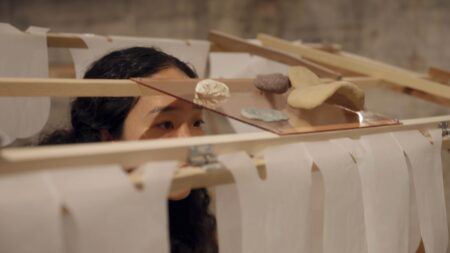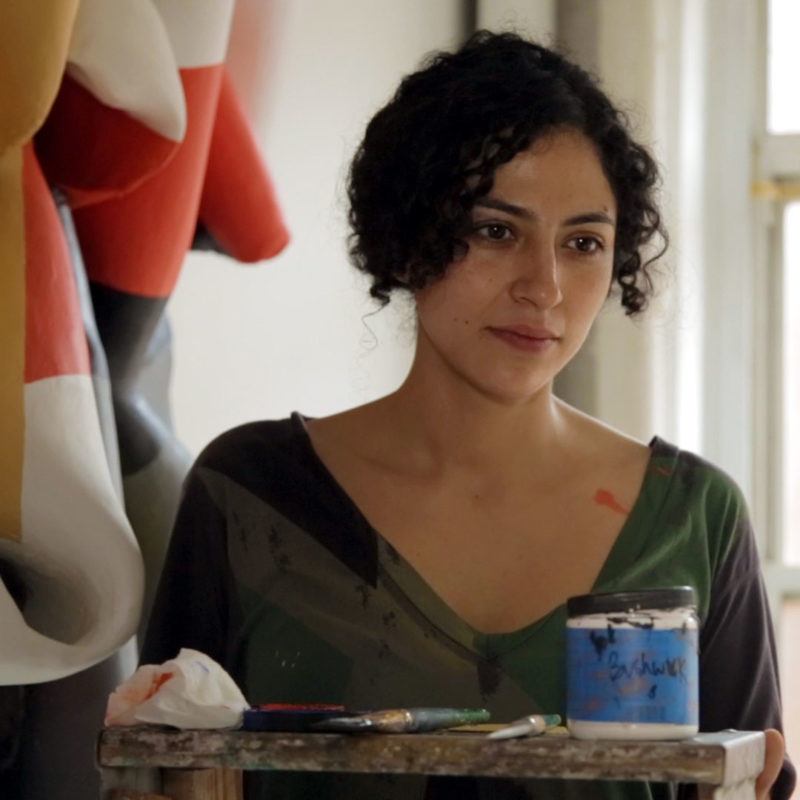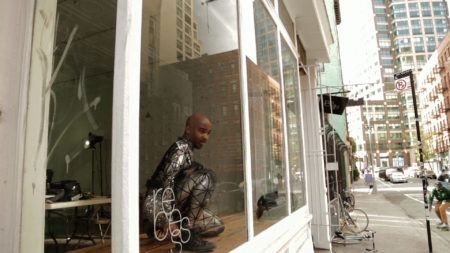Continue playing
(Time remaining: )
Play from beginning
Continue playing "{{ controller.videos[controller.getVideo(controller.currentVideo)].segmentParentTitle}}"
{{controller.videos[controller.getVideo(controller.currentVideo)].title}} has ended.
Marela Zacarías's Work Finds A Good Home
What happens to an artist’s work after it leaves a museum? Artist Marela Zacarías moves a suite of sculptures titled Supple Beat from the Brooklyn Museum to different spaces in the borough. At Zacarías’s Gowanus, Brooklyn studio it’s evident that the space she has to create and store her large-scale works in is extremely limited—a stark contrast to the museum’s wide-open Grand Lobby where Supple Beat is being exhibited (as part of the museum’s on-going Raw/Cooked series). Zacarías and a crew of art handlers led by Collections Manager Walter Andersons deinstall four of the sculptures.
Constructed in carefully conceived parts, their painted geometric patterns cover window screen and joint compound understructures. Zacarías shares her inspiration: the Williamsburg Murals that were created in the late 1930s for a Brooklyn public housing complex and painted directly on walls in common areas. Overtime, they were neglected and covered up, but eventually restored and moved to the museum where they are on long-term loan. Zacarías describes how this poignant story reflects her feelings about her own work—formally and emotionally resistant to their surroundings, literally “running out from confinement.” After the deinstallation, Zacarías and a group of friends deliver the sculptures to new but temporary homes. Three of them are stored in a do-it-yourself-style storage space in Gowanus, and the fourth, 163–213 Manhattan (2013), is taken to a friend’s loft in Williamsburg. As Zacarías and her crew install the work in this compact space (yet another contrast to the museum) she reflects on this fitting end: 163–213 Manhattan now has a home in Williamsburg like the murals that inspired it. And like those murals, the Williamsburg location is probably only a temporary resting place for Zacarías’s sculpture.
Also featuring the works 122-192 Bushwick (2013), 202-254 Graham (2013), and 215-274 Humboldt (2013).
More information and creditsCredits
Art21 New York Close Up Created & Produced by: Wesley Miller & Nick Ravich. Producer & Editor: Rafael Salazar & Ava Wiland. Cinematography: Rafael Salazar, Ava Wiland & Nick Ravich. Sound: Nick Ravich & Ava Wiland. Associate Producer: Ian Forster. Design & Graphics: Crux Studio & Open. Artwork: Marela Zacarías. Music: Los Músicos de Jose. Thanks: Michael Aitken, Walter Andersons, Brooklyn Museum, Angela Jann, LaGuardia and Wagner Archives, Steven McClure, New York City Housing Authority, Alex Nuñez (A.K.A. DJ Miami Heat), Isaac Parker, Weston Pew, Ben Pomeroy, Michael Roopenian, Eugenie Tsai, Sally Williams, Jeffrey Wisotsky. An Art21 Workshop Production. © Art21, Inc. 2013. All rights reserved.
Closed captionsAvailable in English, German, Romanian, Italian, Japanese, Korean, Chinese, Italian
Through the Art21 Translation Project, multilingual audiences from around the globe can contribute translations, making Art21 films more accessible worldwide.
Interested in showing this film in an exhibition or public screening? To license this video please visit Licensing & Reproduction.
Marela Zacarías was born in 1978 in Mexico City, Mexico, and currently lives and works between New York and Mexico City. A muralist painter for more than ten years, Zacarías wanted to bring walls into three-dimensional space. Her resulting wall-mounted painted sculptures twist and turn in unruly ways, built from window screens, joint compound, and polymer before being painted in bold, geometric, abstract patterns. Explaining her shift away from figurative painting, Zacarías says, “I feel like abstraction really allows for the story to be filtered and to come out in a different way in which people can see it or not see it at all.”




